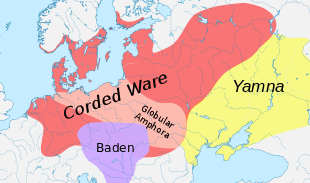Baden culture

The Baden culture (otherwise known as the Boadun culture), ca 3600 BC-ca 2800 BC,[1] is an eneolithic culture found in Central and Southeast Europe. It is known from Moravia (Czech Republic), Hungary, Poland, Slovakia, northern Serbia, western Romania and eastern Austria. Imports of Baden pottery have also been found in Germany and Switzerland (Arbon-Bleiche III), where it could be dated by dendrochronology.
History of research
The Baden culture was named after Baden near Vienna by the Austrian prehistorian Oswald Menghin. It is also known as the Ossarn group[2] or Pecel culture. The first monographic treatment was produced by J. Banner in 1956. Other important scholars are E. Neustupny, Ida Bognar-Kutzian and Vera Nemejcova-Pavukova.
Baden has been interpreted as part of a much larger archaeological complex encompassing cultures at the mouth of the Danube (Ezero-Cernavoda III) and the Troad. In 1963, Nándor Kalicz had proposed a connection between the Baden culture and Troy, based on the anthropomorphic urns from Ózd-Centre (Hungary). This interpretation cannot be maintained in the face of radiocarbon dates. The author himself (2004) has called this interpretation a "cul-de-sac", based on a misguided historical methodology.
Chronology
Baden developed out of the late Lengyel culture in the western Carpathian Basin. Němejcová-Pavuková proposes a polygenetic origin, including southeastern elements transmitted by the Ezero culture of the early Bronze Age (Ezero, layers XIII-VII) and Cernavoda III/Coțofeni. Ecsedy parallelises Baden with Early Helladic II in Thessaly, Parzinger with Sitagroi IV. Baden was approximately contemporaneous with the late Funnelbeaker culture, the Globular Amphora culture and the early Corded Ware culture. The following phases are known: Balaton-Lasinya, Baden-Boleráz, Post-Boleráz (divided into early, Fonyod/Tekovský Hrádok and late, Červený Hrádok/Szeghalom-Dioér by Vera Němejcová-Pavuková) and classical Baden.
| Phase | Subgroups | Date | sites |
|---|---|---|---|
| Balaton-Lasinya | - | 3700 BC cal | - |
| Boleráz | - | 3500 BC | Pilismarot |
| Ia | Štúrovo | - | Letkès |
| Ib | Nitriansky Hrádok | - | Lánycsok, Vysoki breh |
| Ic | Zlkovce | - | Balatonboglár |
| Post-Boleraz | - | ||
| early | Fonyod/Tekovský Hrádok | - | - |
| late | Červený Hrádok/Szeghalom-Dioér | - | - |
| Classical Baden | 3400 BC | - | |
| II, III | older | - | Nevidzany, Viss |
| IV | younger | - | Uny, Chlaba, Ózd |
Settlement
The settlements were often located on hilltops and were normally undefended.
Burial
Both inhumations and cremations are known. In Slovakia and Hungary, the burned remains were often placed in anthropomorphic urns (Slána, Ózd-Center). In Nitriansky Hrádok, a mass grave was uncovered. There are also burials of cattle. Up to now, the only cemetery known from the early Boleráz-phase is Pilismárot (Hungary), which also contained a few examples of stroke-ornamented pottery.
In Serbia,[3] anthropomorphic urns were found in the towns of Dobanovci, Gomolava, Perlez and Zemun.
Economy
The economy was mixed. Full-scale agriculture was present, along with the keeping of domestic stock—pigs, goats, etc. The Baden culture has some of the earliest attestation of often wheeled, wagon-shaped models in pottery, sometimes with a handle. There are burials of pairs of cattle that have been interpreted as draft animals. Though there are no finds of actual wagons, some scholars take these finds together as proof for the presence of real wagons.
Interpretation
In the Kurgan hypothesis espoused by Marija Gimbutas, the Baden culture is seen as being Indo-Europeanized. For proponents of the older theory that seeks the Indo-European homeland in central Europe in the area occupied by the preceding Funnelbeaker culture, it is similarly considered Indo-European.
See also
Notes
- ↑ The corresponding Blytt-Sernander climate phase is the Subboreal.
- ↑ Colledge, Sue; Conolly, James (2007). The Origins and Spread of Domestic Plants in Southwest Asia and Europe. Walnut Creek: Left Coast Press. p. 214. ISBN 978-1-59874-988-5.
The Ossarn group represents a later phase of the Baden culture, with sites located in Lower Austria south of the Danube and in northern and central Burgenland.
- ↑ Dragoslav Srejović, "Kulture bakarnog i ranog bronzanog doba na tlu Srbije"
Sources
- J. Banner, "Die Peceler Kultur. Arch. Hungarica 35, 1956.
- Vera Němejcová-Pavuková 1984. "K problematike trvania a konca boleazkej skupiny na Slovensku". Slovenska Arch. 34, 1986, 133-176.
- J. P. Mallory, "Baden Culture", Encyclopedia of Indo-European Culture, (Fitzroy Dearborn), 1997.
| Wikimedia Commons has media related to Baden culture. |